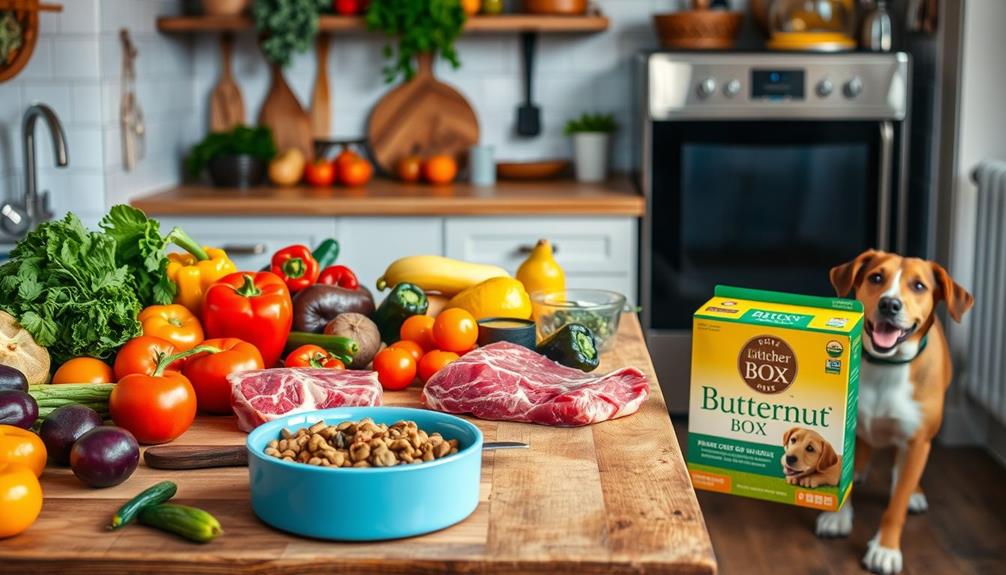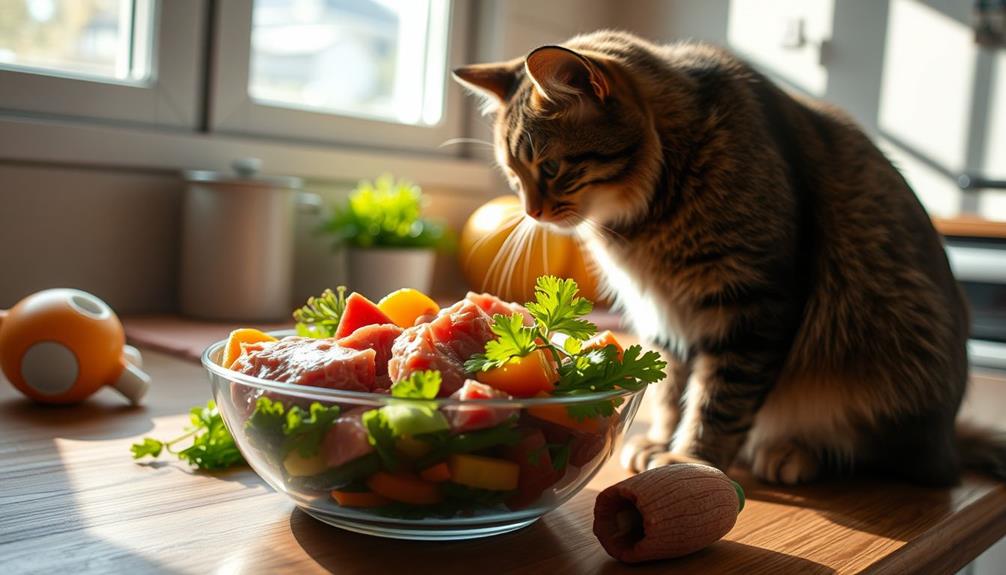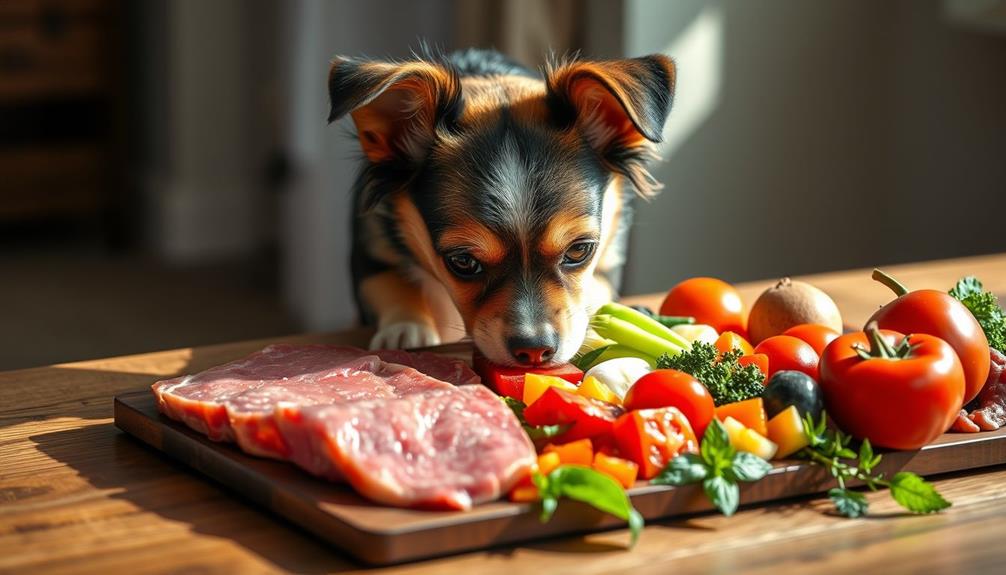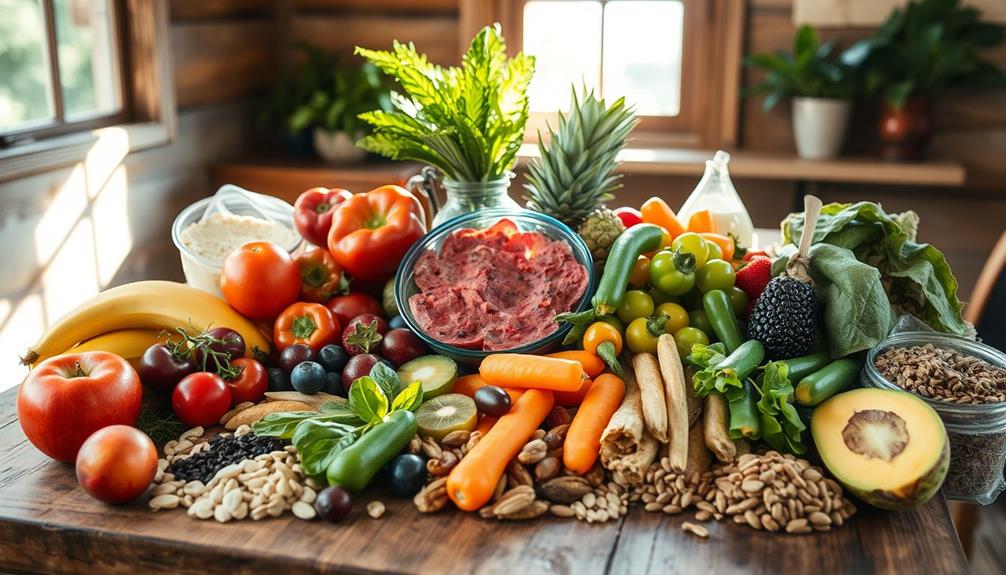Yes, raw food can cause diarrhea in dogs, particularly when shifting from kibble to a raw diet. During this adjustment, your dog's digestive system might react to the new proteins and fat content, leading to softer stools. It's important to introduce raw food gradually over about 7-10 days to minimize any gastrointestinal upset. Additionally, monitor stool consistency closely; persistent diarrhea beyond a week may indicate other health issues. Choosing lean protein sources and ensuring a balanced diet can help maintain digestive health. There's more you should know to keep your pup healthy on a raw food diet. Additionally, it’s important to handle raw food for your dog with care as there is a risk of bacterial contamination, including salmonella. Proper hygiene and storage practices are crucial to minimize this risk. It’s also important to note that while dogs have a lower risk of contracting salmonella from raw food compared to humans, it is still a possibility. Therefore, it’s important to consult with a veterinarian and do thorough research before transitioning your dog to a raw food diet. Can dogs contract salmonella from raw food? Yes, they can, so precautions and proper handling of raw food are essential for their health and safety.
Key Takeaways
- Diarrhea may occur in dogs when transitioning to a raw food diet due to digestive adjustments and changes in gut flora.
- Gradual transitions over 7-10 days help minimize digestive issues and allow dogs to adapt to new protein sources.
- Softer stools are common during the adjustment period; however, persistent runny stools may indicate health issues requiring veterinary consultation.
- Balancing protein sources and following dietary guidelines, like Frankenpray, can prevent diarrhea and promote digestive health.
- Maintaining proper hygiene and monitoring stool consistency are essential to ensure a successful raw food diet transition.
Understanding Raw Diets
When it comes to understanding raw diets for dogs, you'll find that raw meat-based diets (RMBDs) encompass various options, like home-prepared meals or commercial products such as frozen and freeze-dried foods. A raw food diet requires careful nutritional balancing to guarantee your dog receives all necessary nutrients.
Many pet owners—about 15% to 25% for dogs—are opting for these diets, often without prior consultation with a veterinarian. Proper diet considerations are equally important for other pets, such as hamsters, where safe snacks for hamsters emphasize moderation and nutritional balance.
Transitioning to raw can lead to digestive adjustments, particularly during the initial phase when your dog's digestive system adapts to the new food. While raw diets can result in smaller, firmer stools, sudden changes or improper balance might cause gastrointestinal upset, including diarrhea.
It's vital to introduce new protein sources gradually, as consistent meal routines can help prevent digestive issues.
If you choose to feed your dog a raw food diet, keep an eye on their health. Some health problems can arise from an inadequate or unbalanced raw diet, so monitoring your dog's response is key.
Transitioning to Raw Food
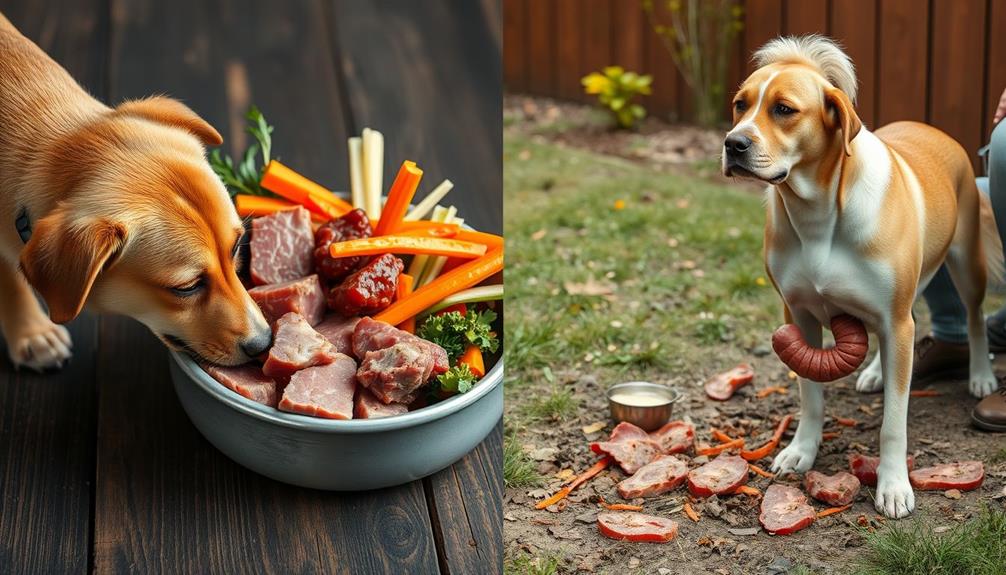
When you shift your dog to a raw food diet, it's essential to do it gradually over 7-10 days, starting with 75% of their old food.
This gradual approach is important to avoid digestive issues, similar to how a careful shift to cold medications can minimize side effects in humans.
Keep an eye on their stool consistency during this period, as softer stools are common and may require adjustments.
This careful approach helps minimize digestive upset and guarantees a smoother switch for your furry friend.
Gradual Transition Importance
Shifting to a raw food diet requires careful planning to guarantee your dog's digestive system adjusts smoothly. A gradual adjustment over 7-10 days is essential to minimize digestive upset and prevent health problems.
Understanding financial considerations for elderly care can help you manage the costs associated with your pet's dietary needs. Start with 75% of your dog's current food and 25% raw, gradually increasing the raw portion. This method helps avoid loose stools and gastrointestinal issues that can arise from sudden changes.
Here are some key steps for a successful adjustment:
- Monitor your dog's response: Keep an eye on their stool consistency; runny stools may mean you need to dial back the raw food ratio.
- Maintain a consistent protein source: Stick to the same type of protein during the adjustment to help your dog's body adjust more easily.
- Be patient: Some dogs may take longer than others to adapt, so be prepared for a potential adjustment period of up to a month.
Monitoring Stool Consistency
Monitoring your dog's stool consistency during the change to a raw food diet is vital for their health. During the transformation period, it's common to see softer stools as your dog adjusts to the new diet. This adjustment can be influenced by various factors, including the dog's prior diet and individual digestive system adaptability, as highlighted in key domains of development.
To minimize digestive disturbances, aim for a gradual changeover over 10-14 days. Start with 25% raw food combined with 75% of their old diet, and closely observe their stool response. Adjust the raw food ratio based on their stool consistency.
If you notice runny stools that persist beyond 7-10 days, it might indicate underlying health issues, and consulting a veterinarian is vital. While loose stools can be part of the detox process from their previous diet, consistent monitoring is key to ensuring your dog's digestive health.
Pay attention to stool characteristics, including color, consistency, and frequency, as these provide valuable insights into how well your dog is adapting to raw feeding.
Causes of Diarrhea
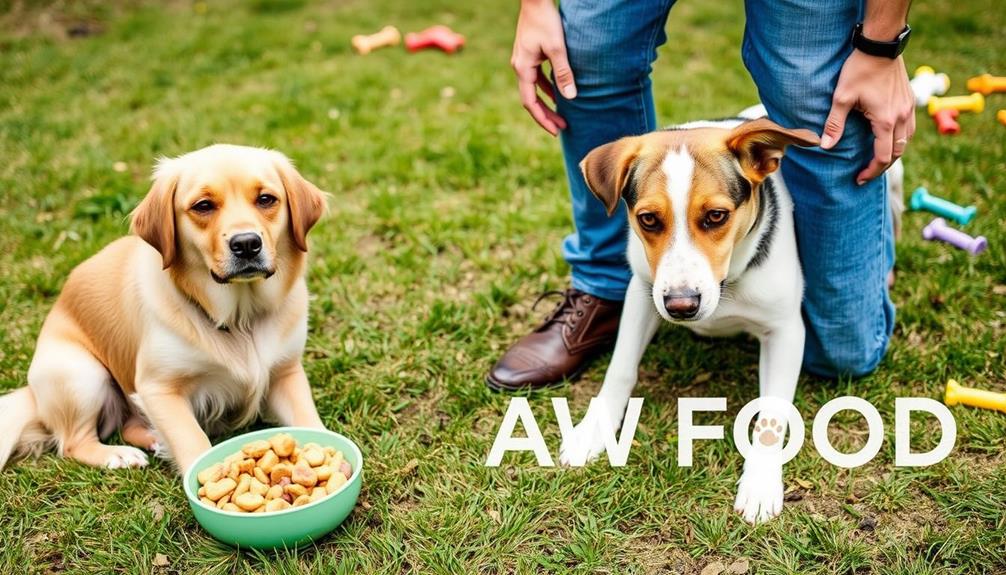
When you switch your dog to a raw food diet, you might notice diarrhea as their digestive system adjusts to the new ingredients.
This adjustment can be similar to how humans may experience gastrointestinal issues when changing their diets, especially with foods rich in antioxidants, like cranberry juice.
The type and balance of protein sources can also play an important role; mixing different proteins or not following the recommended ratios can upset their stomach.
It's important to make these changes gradually and monitor your dog's response to prevent digestive issues.
Dietary Transition Effects
Shifting to a raw food diet can bring about a whirlwind of digestive adjustments in dogs, often leading to diarrhea. During this dietary changeover, your dog's digestive system may struggle to adapt to new food types and ingredient changes.
This can be particularly challenging if your dog has previously been on a kibble diet, as the change in texture and ingredients may disrupt their gut flora. To minimize these effects, it's vital to make the switch gradually over 7-10 days.
Here are some important considerations:
- Monitor stool consistency: Keep an eye on your dog's stools; soft stools or diarrhea after 7-10 days may indicate trouble adjusting.
- Balance fat intake: Introducing high-fat meats too quickly can exacerbate diarrhea. Mix in lower-fat options for a smoother changeover.
- Utilize gut health support: Incorporate gut-healthy toppers or probiotics to aid digestion and reduce the likelihood of loose stools.
Additionally, consider using essential oils for digestive support as a complementary approach to enhance gut health during this changeover.
Protein Source Variability
Variability in protein sources can greatly impact your dog's digestive health, often leading to diarrhea. When you mix different protein sources, some may be harder for your dog to digest than others. For instance, high-fat meats like raw beef, lamb, and duck can contribute to digestive issues, while leaner options such as raw chicken and rabbit are typically easier on the stomach.
Additionally, understanding the importance of budgeting for pet care can help guarantee you provide a well-rounded diet for your dog.
If you introduce new protein sources too quickly, your dog's digestive system might become overwhelmed, resulting in gastrointestinal upset and loose stools. It's crucial to monitor how your dog reacts to each protein source you add to their diet. Food intolerances or allergies can trigger diarrhea, so pay attention to any changes in their stool consistency.
To help prevent diarrhea caused by improper protein source management, consider following the Frankenpray guidelines. A balanced ratio of 80% meat, 10% bone, and 5% liver and organs can support your dog's overall digestive health.
Managing Dietary Balance

A dog's dietary balance plays an essential role in maintaining its digestive health. To guarantee your pup thrives on a balanced raw diet, pay attention to the proportions of meat, bones, and organs. Following the Frankenpray guidelines—80% meat, 10% bone, 5% liver, and 5% organs—can help maintain healthy dogs' stool and prevent diarrhea.
Additionally, securing a clean environment and minimizing allergens can further support your dog's digestive system, similar to how regular cleaning and replacing filters enhances air quality.
Here are some key points to reflect on:
- Monitor protein sources: Introduce new proteins gradually and avoid mixing those that are hard to digest. This will prevent digestive upset.
- Balance fat content: High-fat meats like raw beef and lamb should be balanced with lower-fat options, such as chicken and rabbit, to avoid excessive fat intake that could lead to diarrhea.
- Calcium-phosphorus ratio: Maintaining a proper calcium-phosphorus ratio in your dog's raw diet supports bone health and prevents digestive issues.
Protein Source Considerations
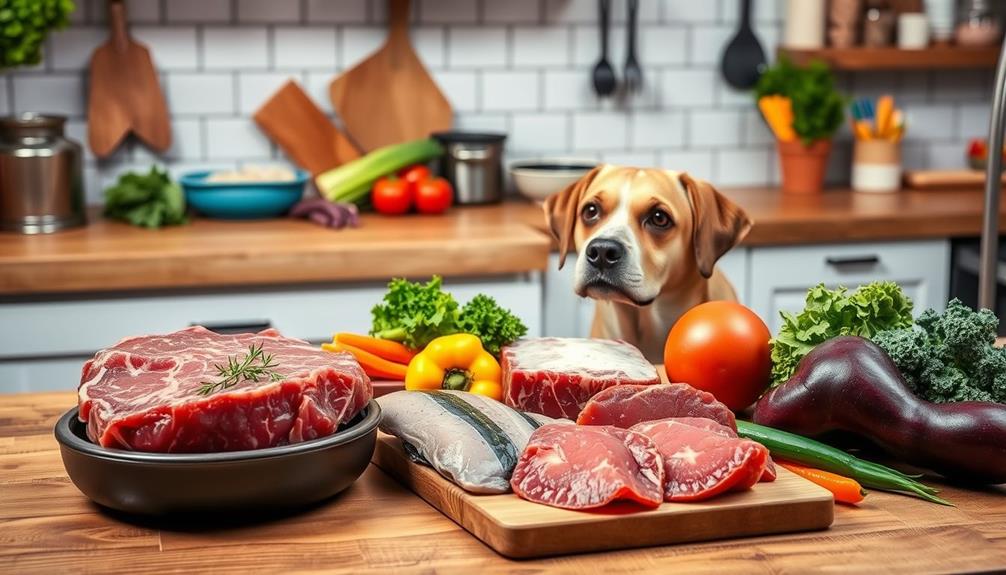
When considering protein sources in your dog's raw diet, it's important to recognize how different proteins can affect digestion. Mixing various protein sources can upset your dog's intestinal tract, as some proteins are easier to digest than others. This imbalance may lead to diarrhea, especially if high-fat meats like raw beef or lamb are included without balancing them with lower-fat options such as raw chicken breasts.
Additionally, understanding how emotional dysregulation can impact a dog's overall wellbeing could be beneficial, as stress can also contribute to gastrointestinal issues.
Gradually introducing new protein sources is essential after your dog has adapted to its initial raw diet. Sudden changes can trigger gastrointestinal upset, resulting in loose stools. Be vigilant about food intolerances or allergies that could arise from specific protein sources. Monitor your dog's reactions closely when you introduce new proteins, as these intolerances can manifest as diarrhea.
Additionally, avoid combinations that can complicate digestion—like mixing milk with raw eggs or serving fatty meats together. These mixtures can increase the risk of digestive issues.
Safety and Hygiene Practices

Maintaining proper safety and hygiene practices is essential for guaranteeing your dog's health on a raw food diet. High-quality content and user experience are critical for pet owners seeking reliable information, as raw meat can harbor harmful bacteria like Salmonella, which poses risks to both pets and humans.
To minimize these risks, you should adopt some key practices.
- Always wash your hands before and after handling raw food.
- Clean all surfaces and utensils thoroughly to prevent cross-contamination.
- Purchase raw meat from reputable sources to reduce the risk of spoilage and foodborne illnesses.
Freezing raw pet food can help lower bacterial counts, but it doesn't completely eliminate them. As a result, safe meat handling is essential.
Regular veterinary checkups are also important for pets on a raw diet, as they help monitor your dog's health and address any zoonotic risks associated with raw feeding.
Adhering to holistic SEO approaches guarantees that you stay informed about best practices in raw feeding.
Monitoring Digestive Health
Monitoring your dog's digestive health is essential during the change to a raw diet. As you make this adjustment, keep a close eye on your dog's stool consistency. It's common to see initial soft stools, which often indicate a digestive adjustment rather than illness.
However, if you notice significant changes in stool color—like red, orange, or black—this could signal potential health issues that require veterinary attention.
You might also observe temporary mucous in your dog's stools, which can be a sign of detoxification. But if the mucous becomes excessive or diarrhea persists, it's important to consult your veterinarian.
Consistent monitoring of your dog's waste can help you identify any dietary issues or intolerances. Typically, raw-fed dogs produce smaller, firmer, and less odorous stools compared to those on processed diets.
Additionally, adjusting the bone-to-meat ratio in the raw diet can improve digestion, leading to better stool quality and overall digestive health.
Benefits of Green Tripe

As you focus on optimizing your dog's digestive health, consider the benefits of incorporating green tripe into their raw diet. This unbleached, cold-washed stomach lining from prey animals is a powerhouse of nutrition. It retains natural probiotics that promote gut health, making it an excellent addition to your dog's meals.
Here are some key benefits of green tripe:
- Rich in Nutrients: It contains essential fatty acids, amino acids, and digestive enzymes that aid in nutrient absorption.
- Supports Immune System: Regular inclusion can enhance your dog's immune system, helping them fend off illnesses.
- Improves Stool Quality: You'll notice firmer, less odorous waste, which is a sign of better digestive health.
Incorporating green tripe into your dog's raw diet not only balances their nutritional profile but also makes the shift to raw food smoother.
Many pet food brands, like ZIWI Peak, recognize its benefits by including green tripe in their recipes. By adding this nutrient-rich option, you'll support your dog's overall health and well-being, ensuring they thrive on their raw diet.
Veterinary Guidance and Support
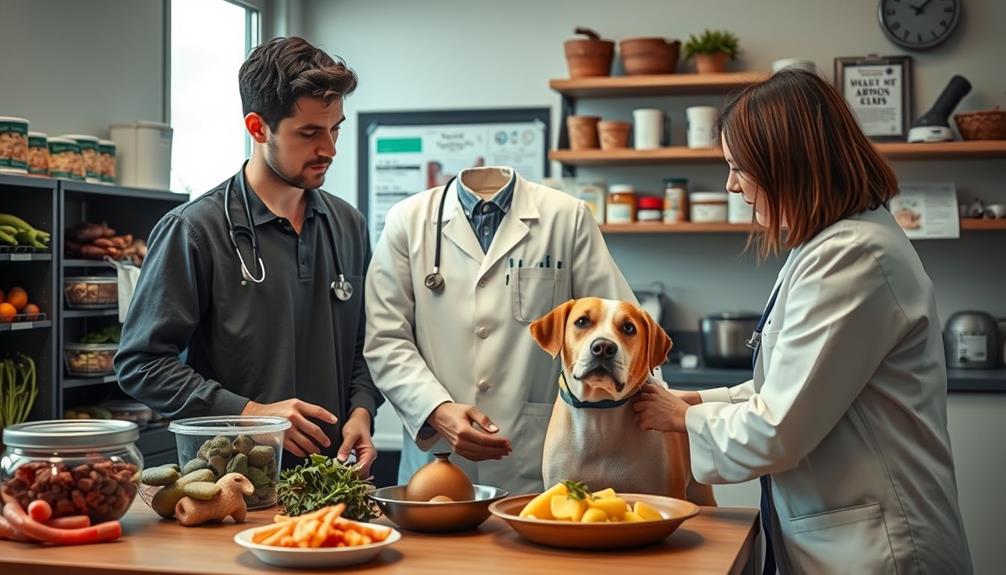
Changing your dog to a raw food diet can be a rewarding experience, but it's essential to seek veterinary guidance to guarantee a smooth process. To minimize digestive upset and potential diarrhea, veterinarians recommend shifting gradually over 7-10 days. This approach helps your dog's digestive system adjust to the new diet.
Regular veterinary checkups are important for monitoring your dog's health during this shift. These visits can help identify any underlying health issues that may lead to gastrointestinal issues. Keeping a record of dietary changes and any digestive problems will facilitate better communication with your vet and guarantee tailored care.
Additionally, your veterinarian might suggest incorporating probiotics and supplements to support gut health during the shift. These can help alleviate diarrhea and promote a balanced digestive system.
Educating yourself about the potential risks associated with a raw food diet, including the possibility of diarrhea, is crucial. By working closely with your vet, you can make informed decisions that benefit your dog's health and well-being.
Always prioritize regular checkups and open communication to guarantee your furry friend thrives on their new diet.
Frequently Asked Questions
Why Does My Raw Fed Dog Have Diarrhea?
Your raw-fed dog might have diarrhea due to a sudden diet change, high-fat meat consumption, or an imbalance of protein sources. Monitor their stool and consider introducing new proteins gradually to minimize digestive upset.
How Do I Know if My Dogs Has Gotten Sick off Raw Food?
If you notice your pup's stool changing dramatically or see signs like vomiting and lethargy, it's time to worry. Don't ignore these red flags; consult your vet for your dog's health and safety.
How to Tell if Dog Food Is Causing Diarrhea?
To tell if dog food's causing diarrhea, observe your dog's stool consistency, color, and frequency. Sudden changes, increased urgency, or mucus may indicate an issue. If diarrhea persists, consult your veterinarian for guidance.
What Does Dog Poop Look Like on a Raw Diet?
You might be surprised to find that dog poop on a raw diet often appears smaller, firmer, and less smelly. Healthy brown stools indicate good digestion, while unusual colors could hint at potential issues you should address.
Conclusion
As you venture into the world of raw food for your dog, remember that the journey can be unpredictable. Diarrhea might lurk around the corner, but with careful planning and monitoring, you can navigate these challenges. The right balance of nutrients and protein sources can make all the difference. So, stay vigilant, keep your vet in the loop, and uncover the benefits that await. Your dog's digestive health could surprise you in ways you never expected!


